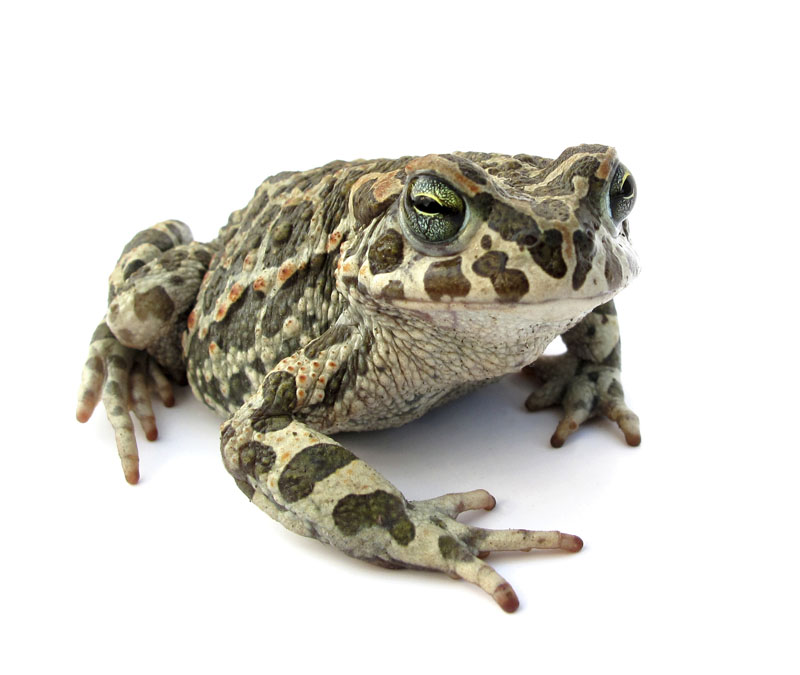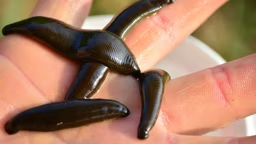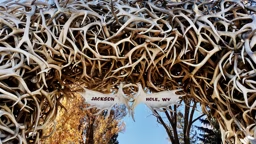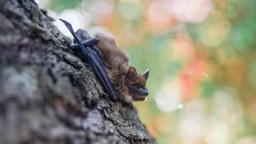As spring waters warm up, frogs begin to belt out their mating songs – frequently in daytime, and with reckless abandon through the night. And while spring signals the return of grilling season and daffodils for humans, these choruses mark the beginning of the frog life cycle – a yearlong journey from one-in-a-thousand egg to aquatic tadpole to land-dwelling adult.
Risky business
In spring, male frogs risk life and limb to advertise their fitness to females. To a male frog, success in breeding outweighs life itself, and some frogs will inflate their throats to sing even in the face of danger. Such persistence may be fatal, but it’s also very attractive to the opposite sex.
The female frog’s “ear,” a membrane much like the head of a snare drum, can hear the male’s song with enough detail to fairly judge the male frog’s strength.
Frogs congregate in the best rearing habitats, where males fertilize eggs as females lay them in giant masses. Although the eggs are fertilized outside of the body, a male frog’s ability to defend a territory and maintain close proximity to a female greatly increases the chances that he will father more young. As spring frog songs wrap up, thousands of new frogs begin their lives.
Typical of animals that make thousands of young in the hopes of a few successful survivors, frogs give little care to tadpoles. Tadpoles are cute, but they have voracious appetites (they’ve been known to resort to cannibalism!), and they must swim through a gauntlet of perils, including would-be predators like insects, fish and birds.
Risky business
In spring, male frogs risk life and limb to advertise their fitness to females. To a male frog, success in breeding outweighs life itself, and some frogs will inflate their throats to sing even in the face of danger. Such persistence may be fatal, but it’s also very attractive to the opposite sex.
The female frog’s “ear,” a membrane much like the head of a snare drum, can hear the male’s song with enough detail to fairly judge the male frog’s strength.
Frogs congregate in the best rearing habitats, where males fertilize eggs as females lay them in giant masses. Although the eggs are fertilized outside of the body, a male frog’s ability to defend a territory and maintain close proximity to a female greatly increases the chances that he will father more young. As spring frog songs wrap up, thousands of new frogs begin their lives.
Typical of animals that make thousands of young in the hopes of a few successful survivors, frogs give little care to tadpoles. Tadpoles are cute, but they have voracious appetites (they’ve been known to resort to cannibalism!), and they must swim through a gauntlet of perils, including would-be predators like insects, fish and birds.
Shape-shifters
Amphibian means “double life” – a fitting name for the creature that transforms from legless, gill-breathing tadpole to legged tadpole, to tailless adult frog with lungs.
While American bullfrogs may take up to 2 years to metamorphose, most frogs and toads go from egg to air-breathing frog much more rapidly and are hopping around in search of a home by late summer.
Despite a rapid metamorphosis, many frog species require a couple of years to reach sexual maturity. A mature, breeding frog is a precious animal. A pond full of chorusing frogs represents a thousand survivors from millions of young.
Dual citizenship
Some toads and frogs spend a great deal of time in dry, grassy meadows and amid the leaf litters of the forest floor, far from water for days at a time. A few species remain on land into the fall and burrow beneath the leaves to hibernate through winter. Others, intent upon reaching water for an aquatic hibernation, migrate to lakes and streams by late summer. Ultimately, the frogs must
return to preferred waters to breed.
Mobility
Without the aid of moving water, frogs can traverse land on powerful legs, eating along the way, until they chance upon a new waterway. With strong legs, webbed feet, and a bullet-shaped body, frogs are excellent swimmers. They have fewer bones than most vertebrates, and some strong bone fusions keep them remarkably strong for their size and durable against impacts caused by leaps into the distant unknown.
Short, stout forelimbs are the norm for frogs that remain on the ground or in the water, but more delicate forelimbs and sticky foot pads are standard issue on species like gray and Cope’s gray tree frogs, who climb trees and perform more delicate tasks, like hanging onto small branches and scaling flat vertical surfaces.
Amphibian means “double life” – a fitting name for the creature that transforms from legless, gill-breathing tadpole to legged tadpole, to tailless adult frog with lungs.
While American bullfrogs may take up to 2 years to metamorphose, most frogs and toads go from egg to air-breathing frog much more rapidly and are hopping around in search of a home by late summer.
Despite a rapid metamorphosis, many frog species require a couple of years to reach sexual maturity. A mature, breeding frog is a precious animal. A pond full of chorusing frogs represents a thousand survivors from millions of young.
Dual citizenship
Some toads and frogs spend a great deal of time in dry, grassy meadows and amid the leaf litters of the forest floor, far from water for days at a time. A few species remain on land into the fall and burrow beneath the leaves to hibernate through winter. Others, intent upon reaching water for an aquatic hibernation, migrate to lakes and streams by late summer. Ultimately, the frogs must
return to preferred waters to breed.
Mobility
Without the aid of moving water, frogs can traverse land on powerful legs, eating along the way, until they chance upon a new waterway. With strong legs, webbed feet, and a bullet-shaped body, frogs are excellent swimmers. They have fewer bones than most vertebrates, and some strong bone fusions keep them remarkably strong for their size and durable against impacts caused by leaps into the distant unknown.
Short, stout forelimbs are the norm for frogs that remain on the ground or in the water, but more delicate forelimbs and sticky foot pads are standard issue on species like gray and Cope’s gray tree frogs, who climb trees and perform more delicate tasks, like hanging onto small branches and scaling flat vertical surfaces.
Quirky anatomy
While most species of frogs can’t turn their heads, a rigid product of bone fusions, the more agile tree frogs can turn their heads from side to side for a better look around.
Large, bulbous eyes on all frogs are excellent at detecting the motion of foe and food. When frogs capture prey, strong muscles at the base of the eyes help to force food into the frog’s muscular throat, making it appear as though the frog is “blinking” the food into its stomach.
A frog breathes air through nostrils that enter directly into the mouth. Just behind its tongue, a ring of muscle and cartilage called a “glottis” opens to the lungs during breathing and seals off the airway during eating or drinking.
A frog doesn’t always force air immediately to its lungs. Instead, it uses movements of its throat to pulse the air around richly vascular tissues inside its mouth, adding oxygen to its bloodstream.
Frogs enjoy supplemental breathing through well-moistened skin as well. When frogs are hibernating, the lungs are forgotten, and all oxygen enters by way of cutaneous “skin breathing.”
Spot-on camouflage
The patterns on a frog’s skin provide a rich variety of camouflage in sun-dappled waters, shadows of grassy meadows, and the scattered duckweeds of a pond’s surface.
Forest frogs, such as the wood frog and spring peeper, have rich brown tones with patterns of black to break up the frog’s outline amid the leaves on the forest floor. Frogs that live near pools and ponds often have bright green colors and patterns that complement aquatic vegetation.
The gray tree frog, with the exception of a flashy set of bright yellow patches along the inside of its legs, is perfectly camouflaged for a life among the lichen-covered trees of its ideal habitat.
While most species of frogs can’t turn their heads, a rigid product of bone fusions, the more agile tree frogs can turn their heads from side to side for a better look around.
Large, bulbous eyes on all frogs are excellent at detecting the motion of foe and food. When frogs capture prey, strong muscles at the base of the eyes help to force food into the frog’s muscular throat, making it appear as though the frog is “blinking” the food into its stomach.
A frog breathes air through nostrils that enter directly into the mouth. Just behind its tongue, a ring of muscle and cartilage called a “glottis” opens to the lungs during breathing and seals off the airway during eating or drinking.
A frog doesn’t always force air immediately to its lungs. Instead, it uses movements of its throat to pulse the air around richly vascular tissues inside its mouth, adding oxygen to its bloodstream.
Frogs enjoy supplemental breathing through well-moistened skin as well. When frogs are hibernating, the lungs are forgotten, and all oxygen enters by way of cutaneous “skin breathing.”
Spot-on camouflage
The patterns on a frog’s skin provide a rich variety of camouflage in sun-dappled waters, shadows of grassy meadows, and the scattered duckweeds of a pond’s surface.
Forest frogs, such as the wood frog and spring peeper, have rich brown tones with patterns of black to break up the frog’s outline amid the leaves on the forest floor. Frogs that live near pools and ponds often have bright green colors and patterns that complement aquatic vegetation.
The gray tree frog, with the exception of a flashy set of bright yellow patches along the inside of its legs, is perfectly camouflaged for a life among the lichen-covered trees of its ideal habitat.
Color-change masters
Most frogs have enough specialized color-change cells that they’re able to vary their color, though a tree frog’s makeover is much more dramatic. Tree frogs are able to quickly change from gray to green.
Frog coloration and their ability to change colors to blend with an environment is tied to specialized cells, a variety of coloring and reflective pigments, and hormonal processes that connect the interactions between the frog’s eyes, nervous system, and some very responsive cells called “chromatophores.” As a frog’s internal balance changes with its perception of the world, the color-changing chromatophores shift the balance of pigments, changing the frog’s appearance.
Going green
Frogs are often effective barometers of environmental conditions. Because a frog’s skin is highly permeable, it absorbs pollutants in waterways. In many places, frog populations are considerably lower than they once were. Caring for frogs entails a deeply analytical caring for our land and water. Road salting, pesticides, and the simple act of flushing our medications down the toilet are tough on frogs. While it isn’t easy being green, it is something we can all lend a hand to.
Flashlight and camera in hand, Brian Collins (www.imagesinnaturallight.com) searches for singing frogs during the midnight show. It’s great fun if you can sneak up on the frogs!
Most frogs have enough specialized color-change cells that they’re able to vary their color, though a tree frog’s makeover is much more dramatic. Tree frogs are able to quickly change from gray to green.
Frog coloration and their ability to change colors to blend with an environment is tied to specialized cells, a variety of coloring and reflective pigments, and hormonal processes that connect the interactions between the frog’s eyes, nervous system, and some very responsive cells called “chromatophores.” As a frog’s internal balance changes with its perception of the world, the color-changing chromatophores shift the balance of pigments, changing the frog’s appearance.
Going green
Frogs are often effective barometers of environmental conditions. Because a frog’s skin is highly permeable, it absorbs pollutants in waterways. In many places, frog populations are considerably lower than they once were. Caring for frogs entails a deeply analytical caring for our land and water. Road salting, pesticides, and the simple act of flushing our medications down the toilet are tough on frogs. While it isn’t easy being green, it is something we can all lend a hand to.
Flashlight and camera in hand, Brian Collins (www.imagesinnaturallight.com) searches for singing frogs during the midnight show. It’s great fun if you can sneak up on the frogs!















